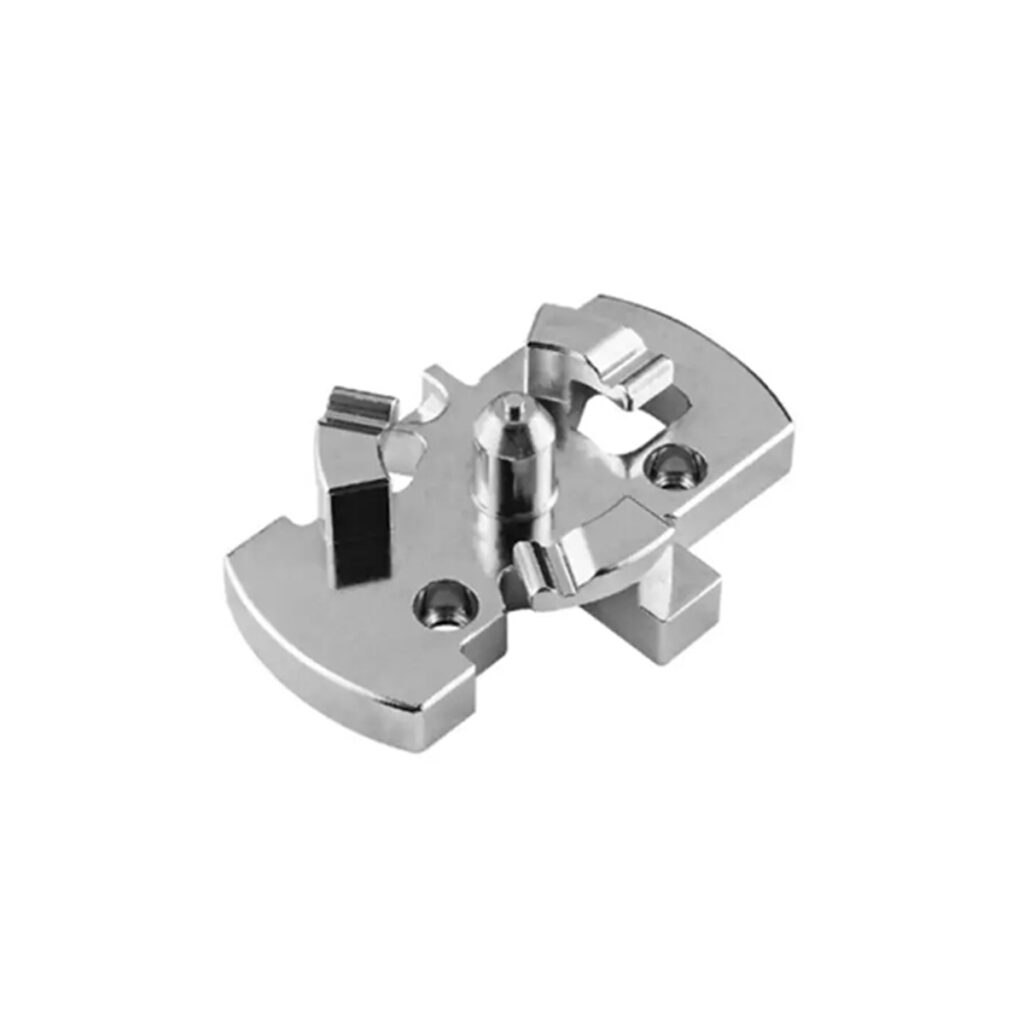In the precise world of CNC machining, the goal is always perfection: a part that meets every dimensional specification, has a flawless surface finish, and functions perfectly in its final assembly. However, the journey from a digital CAD model to a physical part is a complex interplay of physics, tooling, and material science, where even minor inconsistencies can lead to defects.
Understanding these common CNC machining defects is not about assigning blame; it’s about proactive problem-solving. For engineers, designers, and buyers, knowing what to look for and why it happens is the first step in preventing it. This knowledge enables better design choices, clearer communication with your manufacturing partner, and a smoother path to high-quality production.
In this article, we will explore six of the most common CNC machining defects, delve into their root causes, and provide a clear action plan for how to avoid them.
1. Burrs: The Unwanted Sharp Edges
What They Are: Burrs are raised, sharp, and unwanted bits of material that remain on the workpiece after a cutting operation. They are most commonly formed when the cutting tool exits the material, causing it to deform plastically instead of being cleanly sheared off.
- Why They Are a Problem:
- Safety Hazard: Sharp edges can injure assembly and handling personnel.
- Assembly Issues: Burrs can prevent parts from fitting together correctly.
- Functional Failure: In fluid systems, a loose burr can break off and travel, causing blockages or damaging sensitive components.
- Poor Aesthetics: They give a part an unprofessional, unfinished look.
How to Avoid Them:
- Tooling Strategy:
- Use Sharp Tools: A worn or dull tool pushes material instead of cutting it, significantly increasing burr formation.
- Optimize Feed Rates: Sometimes, a higher feed rate can produce a cleaner shear and a smaller burr than a slow one, which allows the tool to rub and push material.
- Select Appropriate Tool Geometry: Specific deburring tools or cutters with polished edges and proper rake angles are designed for cleaner cuts.
- Process Strategy:
- Design for Deburring: Add small chamfers or grooves at edges where burrs are expected, making them easier to remove or less noticeable.
- Automated Deburring: For high-volume production, consider processes like thermal energy method (TEM), vibratory tumbling, or electrochemical deburring.
- Manual Deburring: A necessary but costly secondary operation. Clearly specify critical edges that must be burr-free on the technical drawing.
2. Tool Marks and Poor Surface Finish
What It Is: This refers to visible, often irregular patterns, scratches, or roughness left on the part’s surface by the cutting tool. Instead of a smooth, uniform finish, the surface appears streaked or wavy.
- Why It Is a Problem:
- Aesthetics: Looks unprofessional and low-quality.
- Functionality: A rough surface can increase friction, accelerate wear, create fatigue crack initiation points, and impair the performance of seals.
How to Avoid It:
- Optimize Cutting Parameters:
- Speed, Feed, and Depth of Cut: The holy trinity of machining. An incorrect combination is the primary cause of poor finish. A feed rate that is too high will leave deep, visible marks, while one that is too slow can cause rubbing and work hardening. Use CNC machining calculators to find the right balance.
- Climb Milling vs. Conventional Milling: For most materials, climb milling (where the cutter teeth engage the workpiece at maximum thickness and exit at zero) provides a superior surface finish compared to conventional milling.
- Tooling and Machine Maintenance:
- Eliminate Tool Runout: Even a tiny misalignment of the tool holder can cause vibration and poor finish.
- Use Sharp Tools and Correct Inserts: A worn tool will never produce a good finish.
- Machine Rigidity: A worn-out or low-quality machine with excessive vibration (chatter) will impart those vibrations onto the part’s surface.
3. Chatter and Vibration Marks
What It Is: Chatter is a violent, audible vibration between the workpiece and the cutting tool. It leaves a distinctive, often regular, pattern of waves or lines on the machined surface.
- Why It Is a Problem:
- Catastrophic for Surface Finish: Creates an unacceptable, visibly poor surface.
- Tool Damage: Dramatically shortens tool life and can lead to catastrophic tool failure.
- Machine Wear: Puts undue stress on the CNC machine’s spindle and guides.
- Dimensional Inaccuracy: Can cause the tool to deflect, leading to parts out of tolerance.
How to Avoid It:
- Increase Rigidity: This is the ultimate solution to chatter.
- Shorten Tool Overhang: Use the shortest and thickest possible tool holder and cutter.
- Secure Workholding: Ensure the workpiece is clamped firmly and supported against cutting forces.
- Use Dynamic Toolpaths: Modern CAM software can generate “chatter-free” toolpaths that vary the tool’s engagement angle and depth continuously, disrupting the resonant frequency that causes chatter.
- Adjust Cutting Parameters:
- Vary Speeds and Feeds: Changing the spindle speed can move the process out of a resonant “sweet spot” for chatter.
- Reduce Depth of Cut: A lighter cut can sometimes eliminate chatter, though it may increase cycle time.
4. Geometric Inaccuracy and Misalignment
What It Is: The finished part does not match the geometric dimensions and tolerances (GD&T) specified on the drawing. This includes features that are out-of-round, not parallel, or have incorrect angles. Misalignment often refers to errors from an incorrect machine setup.
- Why It Is a Problem:
- Assembly Failure: Parts simply will not fit together.
- Functional Failure: The component cannot perform its intended task (e.g., a non-round bearing seat will cause premature failure).
How to Avoid It:
- Machine Calibration and Maintenance:
- Regular PMs: Ensure the CNC machine’s ballscrews, guides, and spindles are regularly maintained and calibrated. Backlash in the motion system is a common cause of inaccuracy.
- Proper Warm-Up: Before machining critical parts, run a warm-up cycle to bring the machine to a stable thermal state.
- Workholding and Setup:
- Precise Fixturing: Use high-quality, precise vises and fixtures. Indicate the workpiece to ensure it is perfectly aligned in the machine.
- Tool Length and Diameter Compensation: Correctly set and input tool offsets into the machine control.
- Design for Manufacturability (DFM):
- Avoid Thin Walls: Thin, unsupported walls can deflect during machining, leading to inaccuracies.
- Specify Realistic Tolerances: Not every feature needs to be held to ±0.025mm. Specify critical-to-function tolerances and allow looser ones elsewhere to reduce cost and complexity.
5. Workpiece Deformation
What It Is: The part warps, bends, or twists after being unclamped from the machine, rendering it out of tolerance.
- Why It Is a Problem:
- Scrap Parts: A deformed part is often unusable and must be scrapped.
- Difficult to Correct: It can be very challenging to rework a warped part back into specification.
How to Avoid It:
- Manage Internal Stresses:
- Material Selection: Some materials, especially certain types of aluminum and stainless steel, come from the mill with high internal stresses. Stress-relieved stock should be used for critical components.
- Roughing and Finishing Strategy: Use a multi-stage process. Rough the part, unclamp it to allow stresses to redistribute, then perform a finishing operation. This is often called “rough, stress-relief, finish.”
- Minimize Machining Stress:
- Avoid Excessive Material Removal in One Pass: Taking too deep a cut can introduce new thermal and mechanical stresses into the part.
- Use Sharp Tools and Proper Coolant: This reduces heat buildup, which is a major cause of thermal deformation.
6. Thermal Damage and Burnt Surfaces
What It Is: Excessive heat generated during cutting alters the metallurgical structure of the material. In plastics, this can manifest as melting or discoloration. In metals, it can create a hardened, brittle “white layer” on the surface and draw the temper of the material, softening the area beneath.
- Why It Is a Problem:
- Compromised Material Properties: The part is weaker, more brittle, and susceptible to cracking.
- Premature Failure: Thermally damaged components will fail much earlier than expected under load or fatigue.
How to Avoid It:
- Effective Heat Management:
- Use and Maintain Coolant Systems: Ensure flood coolant is directed correctly at the cutting edge. For high-speed machining, high-pressure through-tool coolant is often essential.
- Optimize Cutting Parameters: High speeds with low feed rates can generate excessive heat. Finding the right balance is key.
- Use Sharp Tools: A dull tool rubs more than it cuts, generating massive amounts of friction and heat.
- Alternative Strategies:
- Compressed Air: For certain materials like plastics or soft aluminum, compressed air is better than liquid coolant for clearing chips and cooling without causing contamination or thermal shock.
Conclusion: The Path to Flawless Parts is a Partnership
While this list covers common issues, it is not exhaustive. A proactive partnership between the customer and the manufacturer is the key to avoiding these and other CNC machining defects.
As a customer, you can help by:
- Providing clear, comprehensive drawings with well-defined, functional tolerances.
- Selecting the most appropriate material for your application.
- Engaging in a Design for Manufacturability (DFM) review with your machining partner before production begins.
A reputable manufacturer will:
- Maintain their equipment in peak condition.
- Employ skilled machinists and programmers who understand how to optimize toolpaths and parameters.
- Have a robust Quality Control (QC) process with advanced metrology equipment to catch issues early.
- Communicate openly about potential problems and solutions.
By understanding these common pitfalls and fostering a collaborative relationship, you can significantly increase the success rate of your CNC machining projects and ensure you receive parts that are not just good but flawless.


